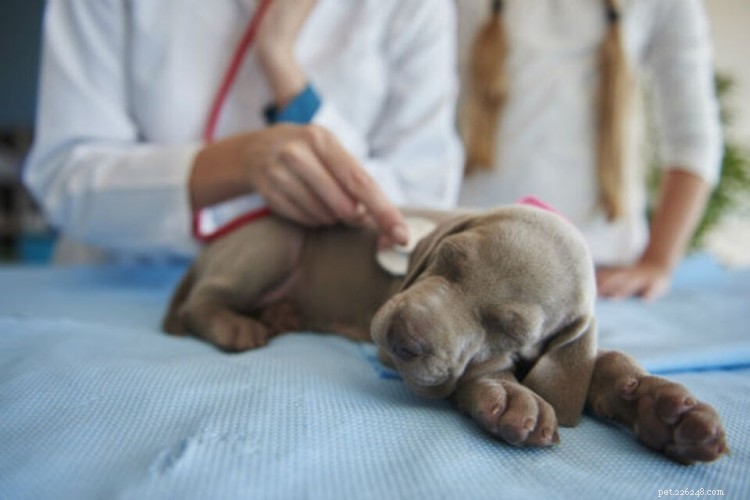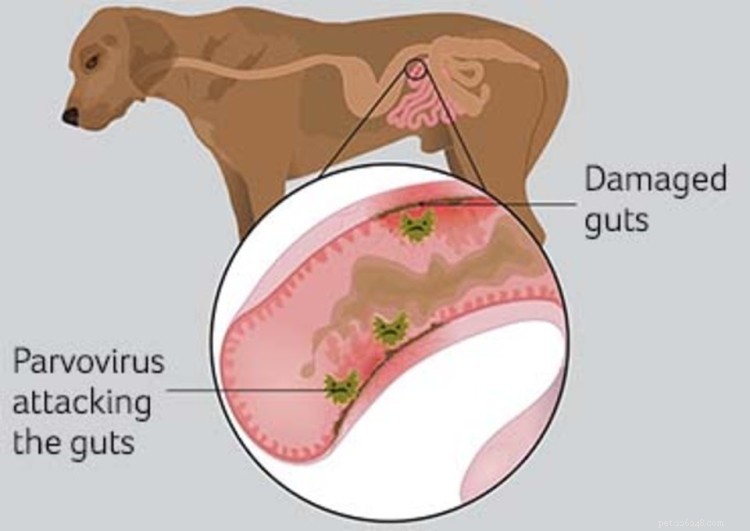Puppy's zijn erg vatbaar voor veel ziekten omdat hun immuunsysteem nog niet volledig is ontwikkeld. Een voorbeeld is parvo, een smerig virus dat de darmen aanvalt en ernstige diarree, braken en uitdroging veroorzaakt. Parvo is zeer besmettelijk en vooral gevaarlijk voor niet-gevaccineerde puppy's jonger dan zes maanden.
Deze gids vertelt u alles wat u moet weten over parvo bij puppy's, inclusief de meest voorkomende parvo-symptomen en de stappen die u kunt nemen om uw huisdier te beschermen tegen deze potentieel dodelijke ziekte.
Pro-tip :De huisdierenverzekering dekt parvo als uw puppy al zijn routinevaccinaties heeft gekregen. U kunt zich het beste inschrijven voordat uw puppy gezondheidscomplicaties krijgt, anders wordt de aandoening mogelijk niet gedekt.
Inhoudsopgave:
Canine parvovirus, bekend als parvo of CPV, is een zeer besmettelijk virus dat het maagdarmstelsel (GI) van puppy's en jonge honden aanvalt . Het virus kan zich gemakkelijk verspreiden door contact met een besmette pup of door indirect contact met een besmet voorwerp, zoals waterbakken, speelgoed en zelfs de handen van mensen.
Het virus valt de maag en dunne darm aan, vernietigt cellen, verslechtert de opname van voedingsstoffen en verstoort de darmbarrière. Bij puppy's kan parvo ook het lymfopoëtische weefsel en het beenmerg aantasten. In sommige gevallen kan het parvovirus de hartspier infecteren (cardiale CPV ), wat meestal fataal is, maar veel minder vaak voorkomt.
Het virus is koude- en hittebestendig en kan tot een jaar buitenshuis en vijf jaar binnenshuis overleven. CPV is bestand tegen alcohol, detergenten en veel desinfectiemiddelen, daarom kan het moeilijk te bevatten zijn.
 (Bron afbeelding:American Kennel Club)
(Bron afbeelding:American Kennel Club)
Puppy's worden blootgesteld aan parvo wanneer ze besmette ontlasting ruiken, likken of aanraken - wat vooral problematisch kan zijn voor jonge honden die de wereld met hun zintuigen verkennen. Parvo-overdracht bij puppy's kan ook optreden wanneer ze in contact komen met een besmet voorwerp of persoon in hun omgeving. Zelfs schoenen die op besmette uitwerpselen trappen, kunnen het virus in huis brengen, waar het tot een jaar in de grond kan leven.
Hoewel alle honden risico lopen, komt parvo het meest voor bij niet-gevaccineerde puppy's tussen zes en twaalf maanden oud . Gelukkig behouden pups jonger dan zes weken nog een deel van de antistoffen van hun moeder, op voorwaarde dat ze de volledige vaccinatiekuur hebben gekregen. Ouders van gezelschapsdieren moeten er rekening mee houden dat bepaalde rassen een hoger risico lopen om besmet te raken met parvo, namelijk:
Neem extra voorzorgsmaatregelen om te beschermen tegen parvo bij puppy's die tot deze rassen behoren.
Puppy's met parvo beginnen het virus binnen vier tot vijf dagen na blootstelling af te scheiden, meestal voordat zich klinische symptomen ontwikkelen. Naarmate de ziekte begint, zijn enkele van de meest voorkomende parvo-symptomen bij puppy's:
Als u een van de bovenstaande rode vlaggen opmerkt, neem dan zo snel mogelijk contact op met uw dierenarts . Zorg ervoor dat u hen van tevoren op de hoogte stelt van de toestand van de puppy en uw zorgen, zodat het personeel de nodige quarantainemaatregelen kan nemen om verdere overdracht te voorkomen.
Eerst zal uw dierenarts bloedtesten uitvoeren om te bevestigen dat uw puppy parvo heeft. The vet might also run an ELISA test to look for CPV antigens in the feces.
Parvo weakens a puppy’s immune system, lowers the white blood cell count, and damages the intestinal wall, reducing the pet’s ability to combat secondary bacterial infections. The mortality rate in canines that receive no treatment is over 90%, compared to 10-25% in those that are hospitalized . Therefore, hospitalization is strongly recommended for puppies with parvo symptoms.
Hospitalizing a puppy for parvo treatment costs about $2,000 to $3,000 just for the first day . Some patients might have to stay in the hospital for three to five days depending on the severity of the case (very sick puppies might stay in the hospital for up to ten days if they require intensive care).
Puppies infected with parvo will be placed in an isolation ward to prevent transmission between doctors, nurses, or other animals in the hospital. They will also receive IV fluids, pain medication, anti-nausea medication, and antibiotics. A nasogastric tube might also be necessary in order to provide nutritional support.
If hospitalization is not possible due to financial reasons, there’s an outpatient protocol that includes learning how to administer anti-nausea medication and IV fluids under the puppy’s skin, administering oral medications, and checking their temperature. Frequent vet visits will be necessary to check blood sugar levels and electrolytes on a daily basis. This option may not be possible depending on the severity of the infection.
Your vet will recommend an appropriate treatment for your puppy’s individual case and let you know which precautionary measures you should take in order to protect any other dogs and puppies in your home.
Pro tip :Treatment for parvo can require 10 days of hospitalization. Without pet insurance that could cost hundreds or even thousands of dollars. Luckily, routine puppy vaccinations, which can be covered through pet insurance plans, include vaccinations for parvo. These vaccinations require multiple shots and vet visits, so pet parents should take some time to compare pet insurance plans and find a policy that will cover this routine care.
 (Image source:PDSA)
(Image source:PDSA)
Most parvo patients recover if aggressive treatment is used and therapy is started before severe dehydration and septicemia occur. Most puppies that make it through the first three to four days will recover completely. Recovery usually takes about a week, but it depends on the severity of the case.
Some breeds, such as the Doberman Pinscher, English Springer Spaniel, and Rottweiler, have a significantly higher fatality rate than other dog breeds.
Puppies continue to shed the parvovirus for up to ten days after recovery, so make sure to keep any animals recovering from the virus away from unvaccinated or partially vaccinated dogs.
Parvovirus is preventable through vaccination . Puppies shoulbe be vaccinated against the virus every two to four weeks starting at six to eight weeks old, up until they are at least 16 weeks old. The last shot at 16 weeks is required for coonfidence in lasting immunity. Until the round of vaccines is complete, they should be kept away from public areas where other unvaccinated dogs could be, such as dog parks.
Ensure that all dogs in your home are vaccinated. It’s very important that female dogs receive a full series of parvo vaccines, as the young puppies depend on the dam’s antibodies in their first weeks of life. Pregnant females can also be boosted with a parvovirus vaccine 2-4 weeks before giving birth in order to transfer higher levels of antibodies to the puppies. Your vet will help you make the final decision about a vaccination schedule that best fits your pet.
You should also be extra careful when socializing your pet. Until puppies have received all of their vaccines, they should be allowed to come into contact with unvaccinated dogs. Avoid dog parks as well as other places where canines gather and try to socialize your puppy in less public environments such as your home.
The stability of the parvovirus in the environment makes it very important to properly clean and disinfect contaminated kennels, crates, bedding, and other areas where infected canines are kept in order to keep the spread under control. A solution of 1 gallon of water and 1/2 cup of chlorine bleach will disinfect water and food bowls, as well as other contaminated items. Your vet can provide specific guidance on cleaning and disinfecting agents for your home.